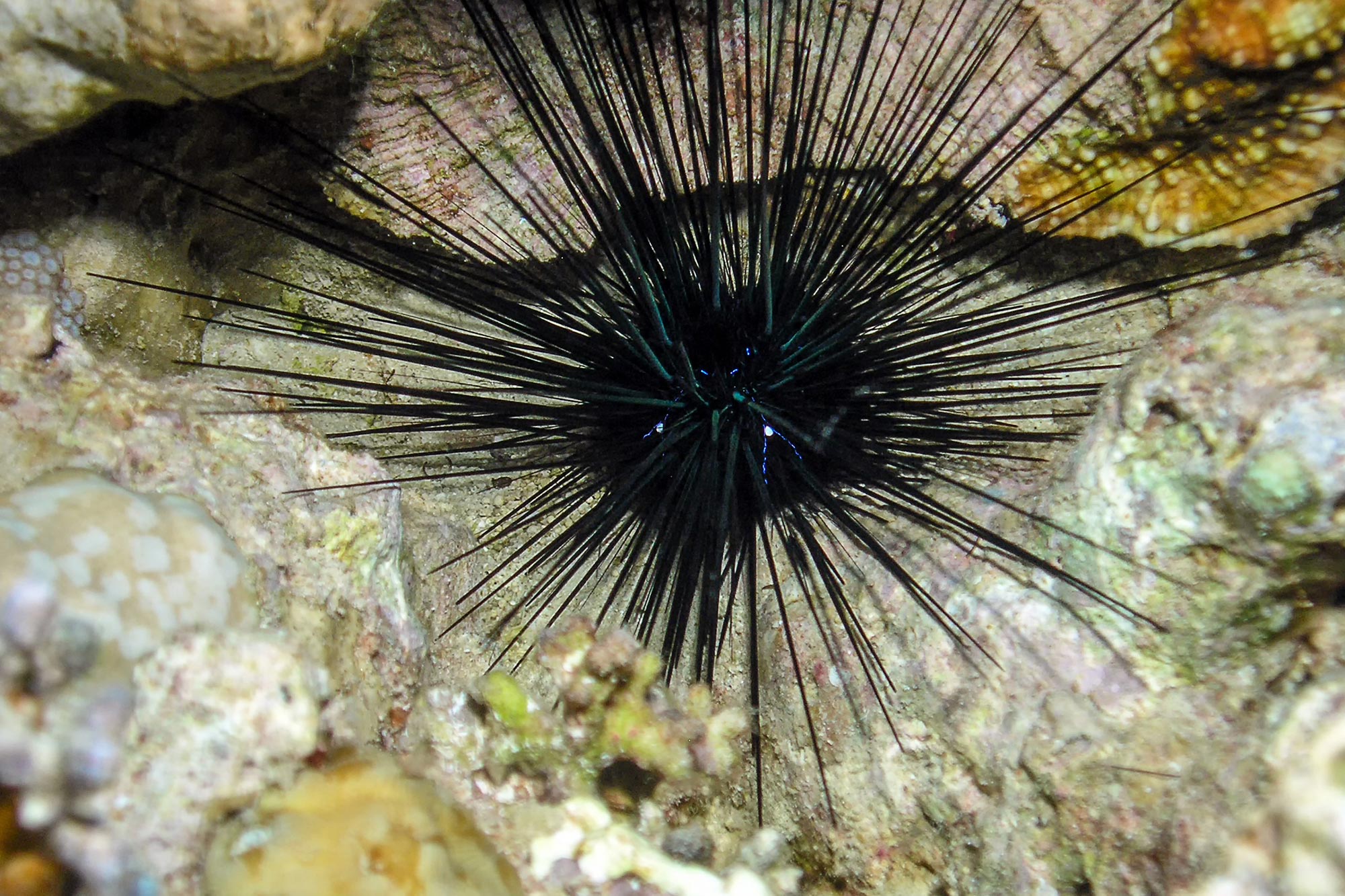
Једноћелијски организам, сцутицоцилиате, идентификован је као узрок масовне смрти морских јежева дугих бодљи 2022. на Карибима и источној обали Флориде. Ови јежеви су од суштинског значаја за здравље коралних гребена, а откриће поставља питања о присуству цилијата, условима њиховог раста и њиховом потенцијалном утицају на друге врсте. Фотографија дугог, бодљикавог морског јежа (Диадема антилларум).
Масовну смрт морског јежа са дугим бодљама – губитак који угрожава здравље коралних гребена од Кариба до источне обале Флориде – проузроковао је једноћелијски организам који се зове цилијат.
Лов на убицу окончан је 2022. који је збрисао морске јежеве дугих бодљи на Карибима и дуж источне обале Флориде. Тим истраживача који је организовала Миа Бреитбарт, уважени универзитетски професор на Колеџу за морске науке Универзитета Јужне Флориде, идентификовао је једноћелијски организам назван цилијар као узрок масовне смрти морске животиње од виталног значаја за здравље коралног гребена.
Њихови налази су објављени 19. априла у часопису Натуре
Ciliate culture viewed under the microscope. Credit: Mya Breitbart USF College of Marine Science
“We’re beyond thrilled to get to the bottom of the 2022 mystery and a bit stunned we did it so quickly,” said Breitbart, senior author on the Science Advances study and an expert in marine genomics. “We had a great team in place and the tools needed to do the ocean science equivalent of a forensic investigation.”
Ciliates are microscopic organisms covered in hair-like structures called cilia that help them move and eat. They are found almost anywhere there is water and most are not disease-causing agents. However, this specific species of ciliate – called a scuticociliate – has been implicated in die-offs of other marine species, such as sharks, in the past.

Photo compilation showing the same sea urchin before and after infection with the ciliate in the USF aquarium research facility. Credit: Makenzie Kerr USF College of Marine Science
Examining urchins collected from 23 sites in the Caribbean, the research team used a series of techniques to confirm the source of the die-off event.
After identifying the ciliate in every affected urchin specimen using genomic techniques, the team grew ciliates in the lab and performed infection experiments at the USF College of Marine Science. When the pathogen was introduced to otherwise healthy urchins in an aquarium tank, the urchins died within a few days – replicating what was taking place in the ocean and confirming the ciliate as the disease source.

DaSc-affected sea urchin, Aruba, August 2022. Credit: Ian Hewson Cornell University
“We’re excited to share this information with everyone, from reef managers to additional scientists so we can explore it further and try to stop its spread,” Breitbart said.

Mya Breitbart (USF) viewing the ciliate culture by microscopy. Credit: Makenzie Kerr USF College of Marine Science
The long-spined sea urchins inhabit shallow tropical waters and feed on algae that would otherwise destroy a reef. They began to lose their spines within days of contracting an unknown disease and died in droves starting in January 2022.
A similar die-off event took place in the early 1980s, which wiped out 98 percent of the long-spined sea urchin population. The culprit of that die-off remains a mystery.
Breitbart first got the call about the unfolding die-off at the end of March 2022. She immediately assembled a team consisting of Ian Hewson, lead author on the publication and a marine ecologist at Cornell University; Christina Kellogg, a microbiologist from the U.S. Geological Survey in St. Petersburg, Fla. who has worked extensively on coral reef diseases; and USF graduate student Isabella Ritchie.
“At the time, we didn’t know if this die-off was caused by pollution, stress, something else – we just didn’t know,” said Hewson, an expert in diseases that cause mass die-offs of sea stars, who flew from New York to the Caribbean Islands to observe the situation.
Even with the source of the mysterious die-off uncovered, questions still remain. For example:
- Is this ciliate new to the area, or was it there prior to the die-off?
- If it has been there, what environmental conditions favored its growth and why did it infect the urchins?
- Can it affect other species of urchins?
хттпс://ввв.иоутубе.цом/ватцх?в=еОИкиИгткУМ
„Једна теорија коју имамо је да је трепавица добро расла у условима високе продуктивности која је примећена на Карибима када је први пут почела да бледи“, рекао је Келог. „Такође смо радознали због чињенице да постоји одређено преклапање у неким географским областима где је дошло до овог изумирања и где корални гребени опадају због болести губитка каменог коралног ткива.
хттпс://ввв.иоутубе.цом/ватцх?в=-нПФН3иКМУк
Референца: „Скутикоцилатни агенс изазива масовну смртност од Диадема Антилларум у Карипском мору“ Иан Хевсон, Исабелла Т Ритцхие, Јамес С Еванс, Асхлеи Алтерра, Доналд Беренгер, Ирене Бовман, Марилин Брандт, Каила А. Бад и Ролио А. Камачо, Томас О. Корнвел, Питер Д. Кимани А. Китсон-Волтерс, Патрициа Крамер, Јудитх Ц.Ланг, Харилаос Лесиос, Лаурен Лидди, Давид Маранцик, Степхен Нимрод, Јосхуа Т. Паттерсон, Марит Пистор, Исабел Ц. Ромеро, Рита Селларес-Бласцо, Мориах ЛБ Севиер, Виллиам Шарп, Метју Соуза, Андрина Валдез-Тринидад, Марен ван дер Лан, Брајан Виљанова-Куевас, Марија Виљалпандо, Сара де фон Хуен, Метју Ворам, Том Вејерс, Стејси М. Јанонг, Сумира Замбрано, Алисе Цимерман, Миа Брејтбарт 19. априла 2023. Доступно овде. Наука напредује.
ДОИ: 10.1126/сциадв.адг3200
хттпс://ввв.иоутубе.цом/ватцх?в=9ОХ9Гкгузас
Истраживање су финансирали Национална научна фондација, Аткинсонов центар за брзи одговор за одрживу будућност, АГГРА, Национална управа за океане и атмосферу, Национална фондација за рибу и дивље животиње, Морски резерват Флорида Киз и Комисија за рибу и дивље животиње Флориде.

„Љубитељ пива. Предан научник поп културе. Нинџа кафе. Зли љубитељ зомбија. Организатор.“





/cdn.vox-cdn.com/uploads/chorus_asset/file/25594197/Genki_TurboCharger_Hero.jpg)



More Stories
Када ће астронаути лансирати?
Према фосилима, праисторијску морску краву појели су крокодил и ајкула
Федерална управа за ваздухопловство захтева истрагу о неуспешном слетању ракете Фалцон 9 компаније СпацеКс